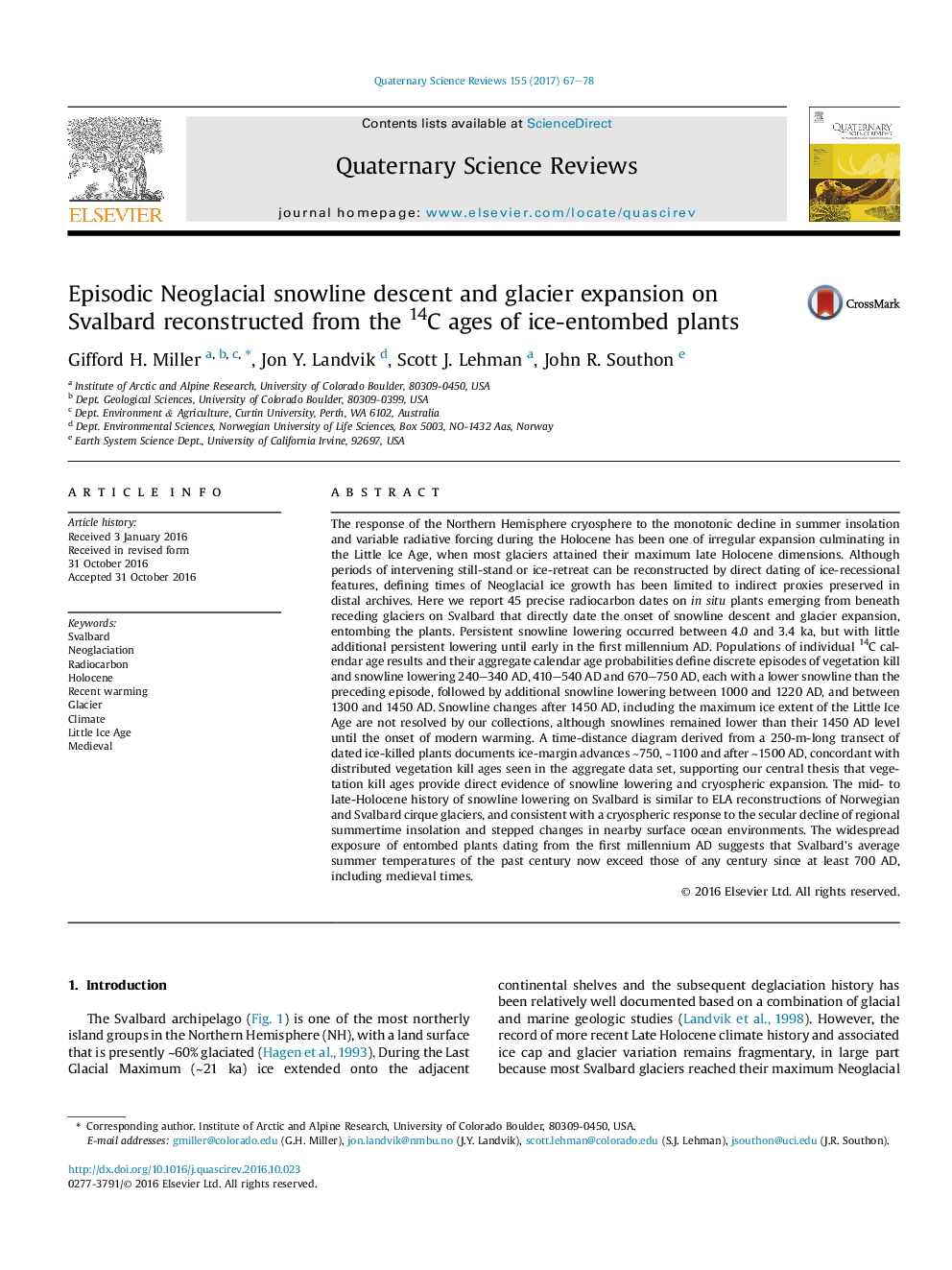| کد مقاله | کد نشریه | سال انتشار | مقاله انگلیسی | نسخه تمام متن |
|---|---|---|---|---|
| 5786839 | 1640780 | 2017 | 12 صفحه PDF | دانلود رایگان |
عنوان انگلیسی مقاله ISI
Episodic Neoglacial snowline descent and glacier expansion on Svalbard reconstructed from the 14C ages of ice-entombed plants
ترجمه فارسی عنوان
نزول اپیکوزی و برش یخبندان و انبساط یخبندان در شهر اسلوبارد از سن 14 سالگی گیاهان اندومتای یخ بازسازی شد
دانلود مقاله + سفارش ترجمه
دانلود مقاله ISI انگلیسی
رایگان برای ایرانیان
کلمات کلیدی
سویلبرگ، بی نظیری رادیو کربن، هولوسن، گرم شدن اخیر یخچال، آب و هوا، عصر یخبندان کوچک، قرون وسطی،
موضوعات مرتبط
مهندسی و علوم پایه
علوم زمین و سیارات
زمین شناسی
چکیده انگلیسی
The response of the Northern Hemisphere cryosphere to the monotonic decline in summer insolation and variable radiative forcing during the Holocene has been one of irregular expansion culminating in the Little Ice Age, when most glaciers attained their maximum late Holocene dimensions. Although periods of intervening still-stand or ice-retreat can be reconstructed by direct dating of ice-recessional features, defining times of Neoglacial ice growth has been limited to indirect proxies preserved in distal archives. Here we report 45 precise radiocarbon dates on in situ plants emerging from beneath receding glaciers on Svalbard that directly date the onset of snowline descent and glacier expansion, entombing the plants. Persistent snowline lowering occurred between 4.0 and 3.4 ka, but with little additional persistent lowering until early in the first millennium AD. Populations of individual 14C calendar age results and their aggregate calendar age probabilities define discrete episodes of vegetation kill and snowline lowering 240-340 AD, 410-540 AD and 670-750 AD, each with a lower snowline than the preceding episode, followed by additional snowline lowering between 1000 and 1220 AD, and between 1300 and 1450 AD. Snowline changes after 1450 AD, including the maximum ice extent of the Little Ice Age are not resolved by our collections, although snowlines remained lower than their 1450 AD level until the onset of modern warming. A time-distance diagram derived from a 250-m-long transect of dated ice-killed plants documents ice-margin advances â¼750, â¼1100 and after â¼1500 AD, concordant with distributed vegetation kill ages seen in the aggregate data set, supporting our central thesis that vegetation kill ages provide direct evidence of snowline lowering and cryospheric expansion. The mid- to late-Holocene history of snowline lowering on Svalbard is similar to ELA reconstructions of Norwegian and Svalbard cirque glaciers, and consistent with a cryospheric response to the secular decline of regional summertime insolation and stepped changes in nearby surface ocean environments. The widespread exposure of entombed plants dating from the first millennium AD suggests that Svalbard's average summer temperatures of the past century now exceed those of any century since at least 700 AD, including medieval times.
ناشر
Database: Elsevier - ScienceDirect (ساینس دایرکت)
Journal: Quaternary Science Reviews - Volume 155, 1 January 2017, Pages 67-78
Journal: Quaternary Science Reviews - Volume 155, 1 January 2017, Pages 67-78
نویسندگان
Gifford H. Miller, Jon Y. Landvik, Scott J. Lehman, John R. Southon,
